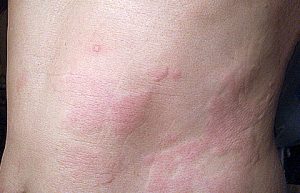Hives
10 ways to get relief from chronic hives
Hives are itchy welts on the skin. They can be caused by:
- An allergic reaction
- A physical trigger, such as cold, water, or pressure
- A medical condition, such as an infection or autoimmune disease
These welts, also called wheals, may be red, pink, white, or skin-colored. Just as they vary in color, hives come in many shapes. Some appear as tiny spots or blotches. Others look like thin, raised lines. Hives also show up on the skin in many sizes. They can be as small as a pinprick, large as a dinner plate, or any size in between.
Regardless of what they look like, hives tend to appear and clear within a few hours. Some people have one flare-up and never get hives again. It’s also possible to have many flare-ups.
If you continue to get hives daily or almost every day for six weeks or longer, you have chronic hives. The medical term for this is “chronic urticaria.”

Hives
When you have chronic hives, the most effective treatment often depends on the type of the hives you have and your medical history.
When you have flare-ups for six weeks or longer, here’s what dermatologists recommend
- Make an appointment to see a board-certified dermatologist, allergist, or primary care doctor. Most people who have hives are otherwise healthy, but it’s still helpful to see a doctor.A thorough medical exam can help rule out possible causes, such as an infection or medication, which could be causing your hives.It’s also possible for a disease, such as a thyroid condition, rheumatoid arthritis, or diabetes to cause hives. If signs indicate that this may be the cause, medical testing can find or rule out these causes.While medications and medical conditions can cause hives, there are many other causes, including foods, insect bites, and pressure on the skin. Sometimes, it’s not possible to find the cause. If that happens, your dermatologist can still recommend lifestyle changes and prescribe medication that can help reduce your flare-ups.
- Keep track of your flare-ups. While it’s not always possible to find the cause, keeping track of your flare-ups may help you figure out what triggers your hives. Some triggers that can cause long-lasting hives are shown below.
Trigger When hives appear Foods: Many foods can cause hives, including peanuts and other nuts, eggs, and shellfish. Hives typically appear within 1 hour of eating the food. Foods (if you have latex allergy): If you already have a latex allergy, bananas, chestnuts, kiwis, or mangos can trigger hives. Hives appear 12 to 24 hours after you eat the food. Additives: Colorings and preservatives used in foods, vitamins and other supplements, spices, cosmetics, skin care products, toothpaste, or other products can trigger hives. Hives usually appear within 12 to 24 hours. Medications: Many medications, including antibiotics, aspirin, and ibuprofen, can be triggers. Hives can occur immediately, days, weeks, or years after you start taking a medication. Cold Hives or an itchy rash appear when you start to warm up after being in cold water or outdoors in the cold. Hives can also appear almost immediately when you go into an air-conditioned building or walk near a freezer case. Heat Hives tend to develop within minutes. Ultraviolet light (sunlight, tanning beds) Hives often appear within minutes. Vibration (very rare cause) Itching and swelling develop when you’re exposed to any vibration. Adrenalin: Stress, exercise, heat, and hot showers, are a few things that cause your body to release adrenalin. Hives appear quickly and last for 30 to 60 minutes. Pressure on your skin: Tight-fitting clothes, sitting, or a purse strap can apply enough pressure to cause hives. Hives can occur when pressure is applied to the skin or appear 4 to 24 hours later. Water (very rare cause) Hives often appear within 1 to 3 minutes of water touching your skin. Touch a plant, animal, or chemical: Stinging nettle, jellyfish, cinnamon, sorbic acid, or latex are common triggers. Usually within minutes, hives (and sometimes difficulty breathing) occur. - Take photos of your hives. When your see your dermatologist, you may not have hives. Taking pictures can help your dermatologist make sure you have hives. Other skin conditions can look like hives.
- Relieve the itch at home. Itch is common in people who have chronic hives. Here are some ways to get temporary relief:
-
- Avoid overheating.
- Avoid overheating.
-
- Wear loose-fitting, cotton clothes.
-
- Apply a cold compress, such as ice cubes wrapped in a washcloth, to the itchy skin several times a day—unless cold triggers your hives.
-
- Use anti-itch medication that you can buy without a prescription, such as an antihistamine or calamine lotion.
- Prevent dry skin by using a fragrance-free moisturizer several times a day.

Hives
The pressure of a purse strap can cause chronic hives where the strap rests on your body.
-
- Stay calm. Stress can trigger hives. If you feel stressed often, healthy ways to reduce your stress include, exercising every day, meditating, and practicing mindfulness.
- Know that treatment can be effective when the cause(s) of your hives remains unknown. It’s helpful to find out what’s causing your hives, but sometimes, a cause cannot be found. About 50% of people who have chronic hives never find out what’s causing their flare-ups.Even when you cannot find the cause, treatment can help you clear your skin and prevent new flare-ups.
- Follow your treatment plan. For treatment to be effective, it’s essential to follow the treatment plan your doctor creates for you.Treatment may fail to work when you take medication less often than prescribed. For example, if your dermatologist prescribes a daily antihistamine and you only take it when you have a flare-up, you may continue to get hives.
- Tell your dermatologist if treatment fails to work. If you are following your treatment plan exactly as instructed, you may still have flare-ups. Hives can be stubborn, but treatment can still work.To give you relief, your dermatologist may:
-
- Increase the dose of a medication
-
- Add another medication to your treatment plan
- Prescribe a different medication
Before changing your treatment plan, be sure you’ve followed the original treatment plan.
-
- Understand that extensive allergy testing rarely helps. Many people believe that their hives would go away if they could just find out what’s causing the flare-ups. Even when the cause remains unknown, treatment can clear your skin and keep it clear.
- Know that chronic hives may go away on their own. About half the people who have chronic hives will stop having flare-ups within 1 year.
With so many possible causes, it’s easy to feel overwhelmed. The good news is that treatment can keep hives under control. Sometimes, it just takes time to find the treatment that works for you.
Images
Getty Images
References
American Academy of Dermatology. “Basic Dermatology Curriculum: Urticaria.” Module last accessed December 14, 2018.
Antia C, Baquerizo K, et al. “Urticaria: A comprehensive review, Epidemiology, diagnosis, and work-up.” J Am Acad Dermatol. 2018;79:599-614.
Antia C, Baquerizo K, et al. “Urticaria: A comprehensive review, Treatment of chronic urticaria, special populations, and disease outcomes.” J Am Acad Dermatol. 2018;79:617-33.
Gratten CEH, Black AK. “Urticaria and angioedema.” In: Bolognia JL, et al. Dermatology. (second edition). Mosby Elsevier, Spain, 2008: 261-75.
Kaplan AP. “Urticaria and angioedema.” Fitzpatrick’s Dermatology in General Medicine (seventh edition). McGraw Hill Medical, New York, 2008: 330-43.
© 2025 American Academy of Dermatology. All rights reserved. Reproduction or republication strictly prohibited without prior written permission. Use of these materials is subject to the legal notice and terms of use located at https://www.aad.org/about/legal
